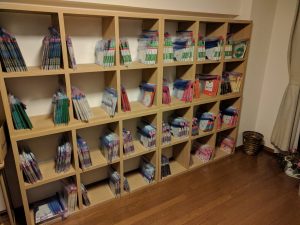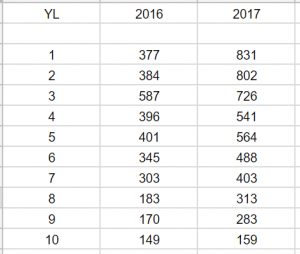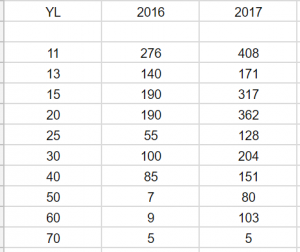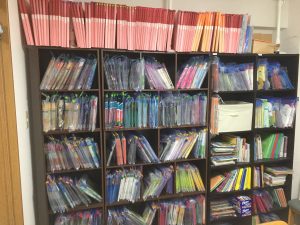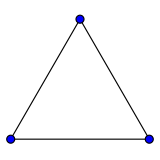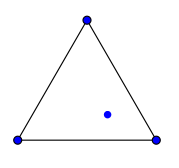Cambridge Academy: Stocktake 2017
Even more stocktake
Our new reading classroom is slowly taking shape
So I finished our annual stocktake today. It’s always interesting to go through and get some numbers. You can see last year’s post here.
This year we have lost some books, but not many , and still not enough to make me want to look for any kind of tracking system for lending. If we started losing a lot more books, or if we got bigger I might consider it, but for now things seem to be okay.
We’ve also bought quite a few books this year. The main acquisitions were intermediate books as more of our students moved into that range, and beginner books to get ready for our 30-odd new JHS1 students who will start next week.
We have also modified how we write yomiyasusa level. Instead of 0.1-9.9, we have changed it to 1-99. Laura M. suggested this to me years ago, and I wish we’d switched earlier 🙂
We’re not going to bother relabelling books, so for a long time we’re likely to have both. I put a section in the student manual to explain so hopefully it won’t be an issue.
Beginner Books (YL1-10)
Big increases in YL1-2 books
You can see the general increase at all levels, and the large increase in the first two levels. I think we’ll have to make similar purchases this year as this cohort moves up, so by next year we should be seeing more robust YL3-5 as well.
Intermediate Books (YL11+)
Still a long way to go!
We’ve made some progress, but our library is still a bit thin at the higher levels. We’ve got a handful of students at YL30 or so, so I predict we’ll be making constant purchases of individual books at these levels this year.
Total Numbers
Just over a 60% increase
Based on this and our needs going forwards, I reckon the library will be over 10,000 books this time next year. Our maximum intake is going to remain 30 students a year for the output classes (looks like we’ll have at least that many next year), so we shouldn’t need to expand the beginner levels for a while after we finish boosting to enough books for 30 students in each year.
Classes start on Saturday, so we are spending a lot of time making new files, replacing the checklist (we’re on version 2.3 now), and I’m trying to finish the student class manual. Wish me luck!
Academy curriculum extensive listening extensive reading high school junior high school school management
by sendaiben
2 comments
Cambridge Academy: Year Two and Three
Takeoff
The Academy appears to be taking off. We have over 30 JHS1 students starting next month, including half a dozen new prospects that found us through word of mouth (some of our students are doing very well in school) or from our new website. Our new fluency-based curriculum is ready for testing. We’ve rented a second reading classroom and are buying a lot of new books.
We haven’t reached 100 students yet (how naive that goal seems now) but we’re getting closer. We should definitely hit it next year if not before.
You can read previous Academy posts here:
- Extensive Reading for Secondary Students (April 2015)
- Six Months In (September 2015)
- Year One (February 2016)
- Looking at Year Two (March 2016)
- Stocktake (March 2016)
- Shadoku explained (April 2016)
- Some improvements to the curriculum (April 2016)
- December 2016 update (December 2016)
More importantly, we have learned a lot over the last few months and should be able to improve class content and avoid operational issues next year.
2016-17 Academic Year
Some highlights from this year:
- shadoku has been a huge success
- our students are starting to make real progress
- we had incredible eiken results this time round
- word of mouth from our success stories seems to be very positive
- students love graduating from guided ER to independent ER
- varied reading materials work very well (particularly comics)
Some lessons learned:
- we had a ‘pre-Academy’ course this year for elementary 6th grade students that just did reading but I am not at all happy with the results so we’ll be discontinuing it
- scheduling was a huge pain this year and some parents got annoyed with us
- our textbook choices were not great -need to tighten up the output class content
2017-18 Academic Year
A few big changes next year. The biggest is that I’ll be teaching all the junior high school classes, both input (reading) and output (communication). I’m doing this because I want to really work on the curriculum and trial our new fluency materials. We will have over fifty JHS students from April.
We’re increasing class sizes. Until now we’ve had output classes of six, but from April we’ll have up to ten students in a class. I think this should be okay, but I’ll have an assistant for each class just in case. For input classes with the new classroom we’ll be able to increase our max class size from 12 to 22.
We’ll be trialing our new fluency materials with thirty JHS1 students. Limited trials so far seem to indicate that the materials are interesting and easy-to-understand for students. We’ll see how they do over an entire academic year.
We’ll finally have some student manuals that explain the program and what students should be doing in Japanese. Based on my experience of using manuals with university students I expect this will make things more efficient. It will also help parents to understand what we are doing and why.
We’ll be making some administrative changes too to reduce friction and paperwork. The most important is that I already know what days of the week will be JHS1 classes from April 2018. This means we can tell parents about them sooner and have them sign up in January for classes (first come first served). We’ll be asking them to pay the annual fee in order to register, which should reduce sudden cancellations (or at least compensate us somewhat for them).
We’ll be buying a lot of books. I just ordered 300,000 yen’s worth of books for our YL0.1-0.2 library (to deal with those 30+ JHS1 students coming in next month). This will last us a few months, but then we’ll have to make a similar order for YL0.3-0.4, and so on. It looks like 30 is going to be our capacity for a while, so this should be a one-off this year.
I also expect to continue buying intermediate level (YL1.1+) books to expand our collection.
We rented a second reading classroom this month, and will be using it for the JHS1 classes. We’ll keep our current classroom but move the lower-level materials to the new classroom and keep the old one for older students.
Overall
So things are looking good. Growth is slower than I was expecting, but seems to be taking off. Next year should be a big improvement in class quality and I’m hoping to document what I do to make it easier to have other teachers run the classes. We intend to trial our JHS2 fluency materials in 2018 and JHS3 in 2019.
Finally, I think I have figured out how to share the Academy program with other schools. We are creating something called the Academy Mentor Program (AMP) which is basically a time-limited franchise (schools stop paying fees after a few years and can continue using the program). I think it’s a win-win-win. If all goes well we’ll be doing a Beta in 2018.
Anyone else doing interesting things with junior high school students? Would you be interested in getting support/materials/knowhow to launch your own Academy program? Any good books in the YL1.1-3.0 range?
curriculum junior high school language courses materials publishing
by sendaiben
2 comments
Three Types of Teachers
Perhaps more like three tendencies of teachers
I’ve been thinking about teachers a lot recently, and my own teaching experiences.
I’m starting to believe that there are three teachers archetypes. Few teachers will embody just one of them, but rather will be a mix of the three in different proportions. Maybe something like the introversion-extroversion scale.
So I believe there are ineffective teachers, individual-focused teachers, and system-focused teachers. Each of the points of the triangle above could be labeled with one of these, and all teachers could be shown as a dot inside the triangle.
In my experience most teachers (whether they are effective or not) tend to be individual-focused. They tend to think about the learner or relationships with learners. A few teachers are system-focused. They tend to think about curricula or classroom management.
The best teachers, the most inspirational, the ones that change lives, are highly effective individual-focused teachers.
The teachers that impact the biggest number of learners are highly effective system-focused teachers.
If I had to put myself on the triangle, I’d probably put myself here:
(the top point is individual-focused, the left ineffective, and the right system-focused)
After 17 years as a teacher I like to think I have become more effective, and I have definitely been drifting down and to the right recently.
I’ve been lucky to work with a highly effective system-focused teacher, Dan E., for the last few years. I’ve learned a huge amount from him and am still in awe of his skills and experience.
We’re currently working on a new project for junior high school students that is the most exciting thing I have ever done. I’ll be writing about it more as we get closer to completion.
So what do you think? Have you noticed the three types of teachers? Where would you put yourself in the triangle?
